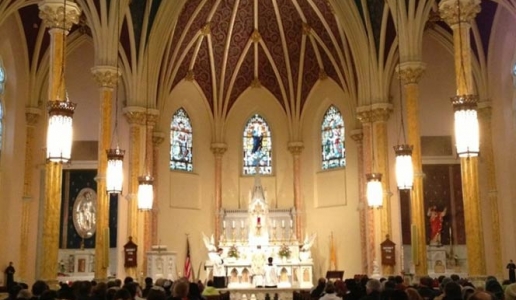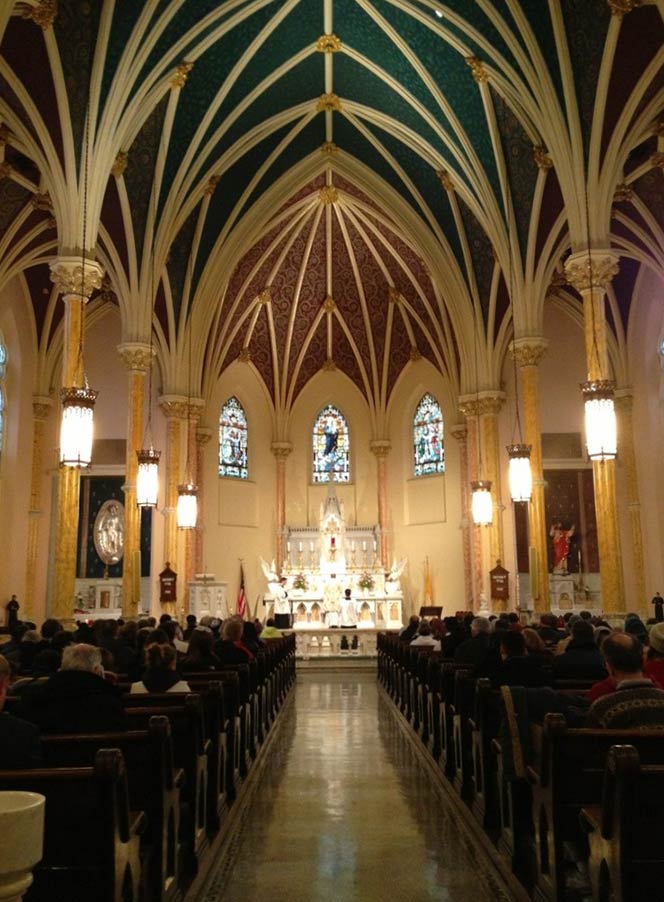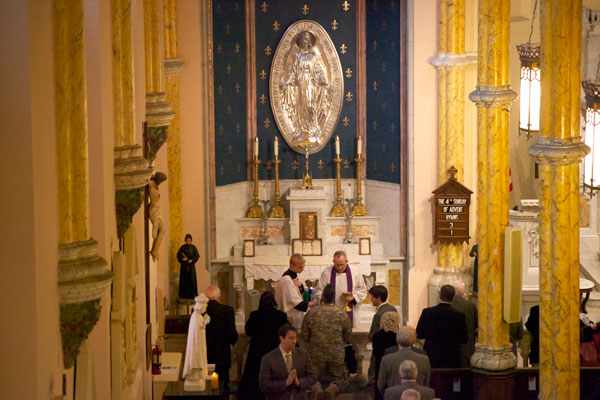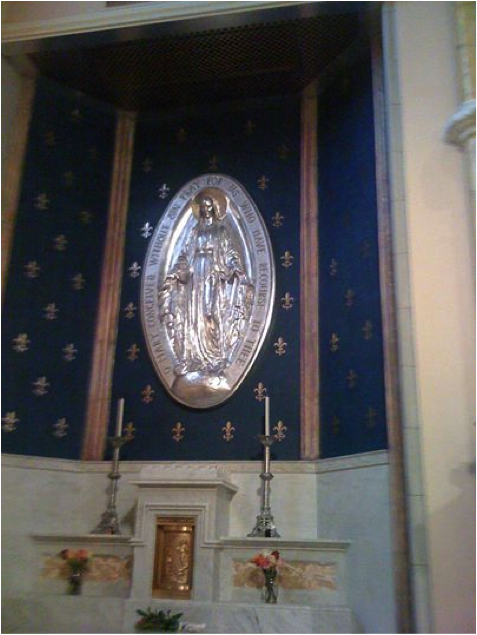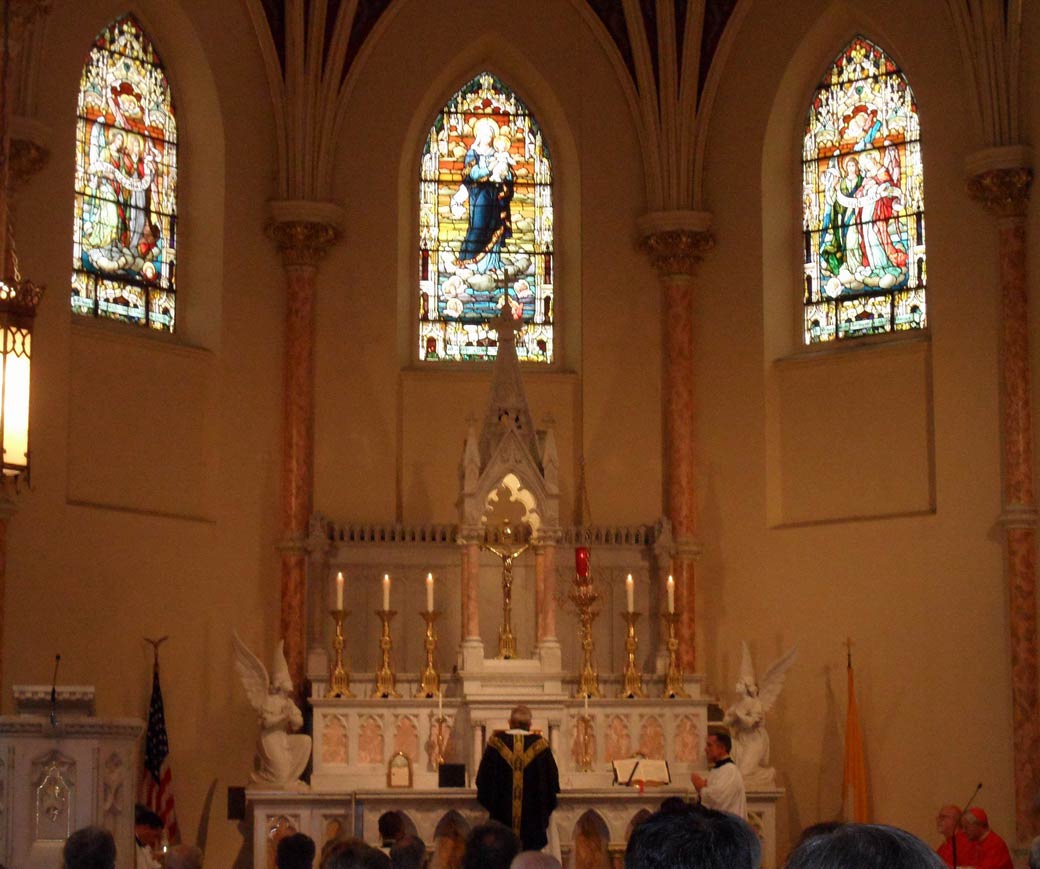Saint Mary Mother of God Church
Location: 727 Fifth Street, NW, Washington, D.C. 20001
Metro: Green, Yellow or Red line to Gallery Place/Chinatown.
by Kathryn Vidrine
O Virgin Mother of God, Mary Immaculate, We dedicate and consecrate ourselves to you under the title of Our Lady of the Miraculous Medal. May this Medal be for each one of us a sure sign of your affection for us and a constant reminder of our duties toward you. Ever while wearing it, may we be blessed by your loving protection and preserved in the grace of your Son. O Most Powerful Virgin, Mother of Our Savior, keep us close to you every moment of our lives. Obtain for us, your children, the grace of a happy death; so that in union with you, we may enjoy the bliss of Heaven forever. Amen.
The Saint Mary Mother of God Church was originally founded by German immigrants in 1845. These German immigrants wanted a place of worship that not only honored Mary as the Mother of God, but also allowed them to be with other German immigrants, as there were not many places in the area that endorsed German culture.1 Churches of America. (1990). Saint Mary Mother of God Church: A History of the Church and the Parish. Chicago, IL.When this church was originally founded, it was also used as a meeting place for many members of the parish, especially the older female German population.
As time progressed, the ethnicities of the people in the area changed, with many of the German parish members moving away and many new Chinese immigrants coming into the area. As the area developed more into what is now known as Chinatown, the church changed as well. It is now, in addition to being of German and American heritage, a Chinese Catholic church as well (fig. 1). This church continued to develop as a meeting place for Chinese immigrants until the Second Vatican Council.2 After the Second Vatican Council, many of the meetings that formerly took place after Mass and other religious events now came before the Mass, cutting down time that parishioners socialized at the establishment. With this change, the church started performing more Masses in various languages, as well as daily rosaries, Adoration, Reconciliation, and other prayer groups.3 This change has lasted and is still part of the many events that the church has happening every day. These events include Masses in English, Latin, and Chinese, recitations of the Rosary, the Miraculous Medal Novena, Adoration, and Reconciliation.4
The outside of the church was rebuilt in 1890, where the new architect, Federro Paxton, tried to keep the same look as the original structure (fig. 2). At that time, because there was a devotion to the Miraculous Medal, the left apse was refurbished to be entirely devoted to it (figs. 3-4). The Miraculous Medal was originally given from Mary, Mother of God, to St. Catherine Labouré in a vision. In the middle of the night of 18-19 July 1830, then Sister Catherine, a novice of the Daughters of Charity in France, was woken up and told by Mary that she had a mission for the novice. Later, Mary showed Sister Catherine the image of the Miraculous Medal and emphasized the importance of spreading this Medal around the world, especially in France as many were struggling at the time. Working with her confessor, Sister Catherine worked to spread the devotion of the Miraculous Medal, only revealing that Mary gave her that vision shortly before her death.5 The parishioners of Saint Mary Mother of God in D.C., many of whom were already performing the devotion of the Miraculous Medal, wished to honor Mary in this way through this church because of the parish’s dedication to Mary, the Mother of God. This church also has special dedications to Our Lady of China.
In 1988, the altar and apse were reconstructed by Eric Mersen, one of the parishioners at the church, using Italian marble and gold flake(fig. 5).6 Aladel, M. (1880). The Miraculous Medal: Its Origin, History, Circulation, Results. University of Mary.Half of the stained glass windows are the same original windows from 1845, with only repairs being made occasionally. These windows depict some of the German saints that were popular during the 1800s, such as Saint Boniface, Saint Hedwig of Silesia, and Saint Hildegard of Bingen. Andrew Centrur, the designer of the original stained glass windows, took the opinions of the parishioners and their desires before designing the windows and constructing them. The other stained glass windows were created in the 1940s, in the same style as the original ones, of popular Chinese saints.7 Many parishioners will sit by specific windows to venerate that saint.
Pilgrims are encouraged to join parishioners for any of the Masses, especially the Tridentine Mass, for Adoration, for the Miraculous Medal Novena, or the recitation of the Rosary. Silent, personal prayer is also welcome.
For more information visit Saint Mary Mother of God
References
| 1. | ⇧ | Churches of America. (1990). Saint Mary Mother of God Church: A History of the Church and the Parish. Chicago, IL. |
| 2. | ⇧ | |
| 3. | ⇧ | |
| 4. | ⇧ | |
| 5. | ⇧ | |
| 6. | ⇧ | Aladel, M. (1880). The Miraculous Medal: Its Origin, History, Circulation, Results. University of Mary. |
| 7. | ⇧ |



